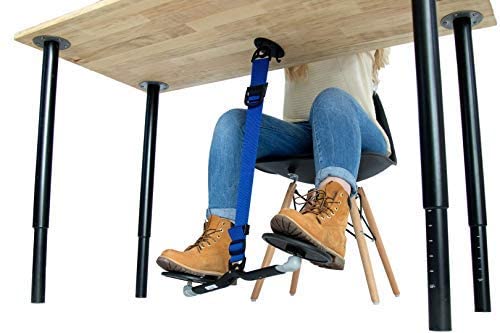Massive shifts in the work-from-home trend have led to increased flexibility in workers’ schedules. More time to complete house chores, spend with family, and nix the commute are all bonuses. But one aspect that may remain rigid could be your physical fitness routine. It is no surprise that regular physical activity is important for your health. With more time to individualize our schedules, we may be under the impression that it is easier to get moving, but for many it might prove more difficult.
One of the biggest problems of working from home is inactivity. According to the World Health Organization, 31% of individuals 15 years of age or older are physically inactive, and approximately 3.2 million deaths per year are attributed to this unhealthy sedentary behavior. The effects of sitting all day pose a risk factor for cardio-metabolic disease, type 2 diabetes, obesity, coronary artery disease, musculoskeletal disorders, some types of cancer, and premature death. Exercise also improves mental health by reducing anxiety, depression, and negative mood.
It’s safe to say we are all fairly confident in the positive effects on overall health that consistently exercising provides, but carving out that time and space in your home is easier said than done. The decrease in energy expenditure can especially be seen currently with social distancing and shelter-in-place orders. With less opportunities to venture outside of our homes and into our favorite gyms or public spaces, making that extra effort to transform our residences into yet another facet of our lives, our workout space, can seem even more taxing.
Easy Home Workouts
The easiest and most effective way to make sure you fit in an exercise program is to pencil it in. Add it to your google calendar, have a smart watch remind you, or even plaster sticky notes around your home office. You should pick the same time every day. Maintaining a workout routine, even when you work from home, is important.
The many effects of exercise on physical and mental health are indisputable. According to Dr. Pollock of American Alliance for Health, physical fitness can be divided into three major categories: cardiovascular-respiratory fitness, physique, and motor function. Exercise programs should focus on increasing strength, endurance, flexibility, power, agility, and balance. When focusing on strength and muscular endurance, you are able to maintain proper muscle tone, which protects against injury or lower back pain, and can improve the detriment that eventual hunching at your desk can cause. Flexibility exercises are also necessary and reduce the risks of poor posture, fatigue, and injury that are often associated with working at a desk.
Whatever activity you choose, it is recommended to exercise 3 to 5 days a week at 60% to 90% of maximum heart rate for 15 to 60 consecutive minutes.
Activities That Can Be Done Indoors
Timed walk or jog
Make it a point to walk around your neighborhood, or even pace back and forth in your living room. Just make sure you keep it going for a set amount of time (20-30 minutes is a good start). You can even utilize stairs if you have access to them. If you have access to trails in your area, hiking can really boost your heart, mind, and body. The fresh air and the beauty of nature may be just the boost you need to prepare for another day working from home.
To explore trails in your area, visit AllTrails website, or download the app for Android or iOS. AllTrails helps you explore the outdoors (and think of fun connected places to work outdoors) with over 100,000 hiking trails and mountain bike routes.
Yoga stretch breaks
Vinyasa yoga is a great practice to increase strength, flexibility, and endurance. It is a type of yoga that strings together different postures, or asanas, using breathing techniques.
Use a mat like Toplus to aid in your practice. This durable, non-slip mat will provide a comfortable foundation to practice a few asanas. It’s also easier to practice yoga in comfortable clothing like high waisted leggings that allow you to move freely during your yoga session.
Research suggests that yoga may help improve general wellness by relieving stress and improving mental and emotional health, sleep, and balance. Yoga helps relieve low-back and neck pains often associated with sedentary jobs. Yoga also provides relief from the stressors and hectic nature of modern life.
Taking a break to practice yoga during your work day not only heals and strengthens the physical body, but induces a balanced mental state.
Examples of different poses can be found here.
Fitness Apps
Fitness apps and trackers are a great way to stay fit and allow virtually any user to create their own exercise routine at any fitness level.
Fitbit Coach (available on Android and iOS: FREE or $39.99/year)
- While there are free workouts, the Fitbit Coach app, available in conjunction with Fitbit watch, is one of the best fitness trackers on the market. It tracks exercise and activity, has innovative sleep tools, and even provides reminders to get up and move each hour. The personalized training app uses dynamic workouts that track goals and progress. It also gives you access to unlimited video workouts and audio coaching.
MyFitnessPal (available on Android and iOS: FREE or $49.99/year)
- MyFitnessPal is one of the best calorie-counting apps on the market. The website and mobile app contains a dense searchable food database. Through its use, users can track macronutrient nutritional information (breakdown of carbohydrates, fats, and proteins) for ultimate weight loss and health tracking.
Nike Training Club (available on Android and iOS: FREE or $119.99/year)
- Nike Training Club app provides free workouts for all fitness levels, including bodyweight-only sessions, yoga classes, targeted training programs, and full-equipment home workouts. There are photo descriptions and video demonstrations of every workout, helping you maintain form. For a limited time due to Covid-19, premium membership remains free.
Incorporate weights into your workouts.
Muscle-strengthening exercises are an important role in cardiovascular health. According to Harvard Health Publishing, to add some simple strength training to your routine, start with two basic exercises that strengthen a wide range of muscles in the body: a squat and a bent-over row.
- Squat: stand up straight with your feet shoulder-width apart. Your toes should be pointed slightly outward. Look straight ahead and keep your chest up and spine in a neutral position. Keep your weight on the heels and balls of your feet and hinge forward at your hips, bending your knees to lower. Keeping your knees in light with your feet and squat down until your hips are lower than your knees. Making sure your knees aren’t bending inward, return to the starting position.
- Bent-over Row: Stand with a weight in your left hand and a bench or sturdy chair at your right side. Place your right hand and knee on the bench or chair seat and bend over at the waist, keeping your lower back tight. Squeeze your shoulder blades together, then bend your left elbow to slowly lift the weight toward your ribs. Return to the starting position.
Grab a weight set like this one from BalanceForm. If you’re on a budget, grab some soup cans. Never underestimate the simple addition of resistance.
HIIT workouts
High-intensity interval training, or HIIT, is a form of interval training. It is a cardiovascular exercise method alternating short periods of intense anaerobic exercise with less intense recovery periods. This is a great way to fit in the same benefits of a longer, less intense workout, in a short period of time.
Accumulated evidence suggests that aerobic capacity is the strongest predictor of future health, mortality, and cardiovascular risks. HIIT and sprint interval training (SIT) increase oxygen uptake and mitigate risks associated with sedentary lifestyles, more so than moderate-intensity continuous training (such as brisk walking, gardening, or dancing). Best of all, you can knock out these style workouts in shorter amounts of time, and with less boredom.
When you’re first starting out, alternate a few short intervals of high-intensity exercise with longer periods of moderate or easy exercise. The goal of HIIT is to push yourself close to your limit, usually to a level of 8 or 9 on a perceived effort scale, with 10 being the maximum.
One example of a beginner HIIT workout is to do a five-exercise routine that works your entire body. According to Harvard Health, start by working for 20 seconds followed by 10 seconds of rest. Complete as many reps as possible.
As the workout becomes easier, perform each exercise only once for 30 to 45 seconds, then rest the remainder of the minute. These exercises below are plyometric and work on your upper and lower body, as well as your core. And don’t forget to breathe continuously throughout the whole workout!
- Jumping Jacks– these warm up the body. Begin in a standing position with legs straight and arms at your side. Jump up and spread your feet beyond hip width apart, bringing your arms above your hand to almost touch. Jump back down to the starting position and repeat.
- Burpees: Lower your body into a squat, and place your hands on the floor directly in front of your feet. Jump your feet back into a plank position, and lower your body to the ground finishing with a pushup. Bring your feet back to your hands, then jump into the air, hands above your hands. Repeat until the time is up.
- Mountain climbers– Start in a high plank position with your shoulders directly over your wrists, shoulder-width apart. Quickly drive each knee into your chest and alternate as if you’re running.
- High Knees– Place your elbows on your ribs, arms parallel to the floor. Drive one knee up toward your chest, hitting your hand at a 90 degree angle. As your foot goes back toward the ground, drive the opposite knee high and out in front of you. Alternate each leg, and go as fast as possible.
- Plank– To achieve a proper plank position, your head should be in line with your spine (eyes should not be forward, but directly down toward the floor). Place your hands directly under your shoulders, with the option to go down onto your elbows if you have wrist issues. Ground your feet onto the floor and squeeze the buttocks, stabilizing the body. Squeeze your shoulder blades together, engaging your core. A common mistake with planks is to spike your hips up, or dip the buttocks down. Your body should be in one, solid line, head to toe.
Move More At Your Desk
The use of active workstations decreases sitting time and its adverse effects, and pose demonstrated benefits for remote and office workers.
Sit-stand desks and other ergonomic office products prove helpful and healthy additions to your workday. Other active workstations, such as walking or cycling workstations, and portable stepping or pedal devices, have a positive effect on general health of users because they- you guessed it- increase active behaviors. These machines decrease sitting times and increase energy expenditure, leading to the myriad of positive effects on work performance and cognitive function.
EXERPEUTIC 900E Bluetooth Under Desk

This portable under desk bike fits the height of any user, and is a great addition to an active workstyle. Bluetooth technology allows you to track your workouts with time, distance, speed, calories burned, and rpm. Exerpeutic’s desk bike hooks to your desk chair to keep you in place while pedaling, and comes with fourteen levels of tension to create any style workout, from easy to challenging.
SITFLOW Under Desk Leg Swing

SitFlow’s under desk leg swing allows you to exercise while you work, improving circulation and posture, and helping you burn calories as you send out pesky morning emails. This swing mounts to your desk and certified by Mayo Clinic and is scientifically proven to increase productivity.
With no end in sight, it is hard to say what lasting effects the COVID-19 pandemic will have on behavior patterns once life begins to return to normal. One facet of our health that we can control is our exercise regime. Numerous fitness institutions have been offering free classes online. A quick search on Youtube will provide endless results for workouts from cardio and strength to yoga, and more. The goal is to get moving, whether you adopt a fitness program, or simply walk for an hour every day.






